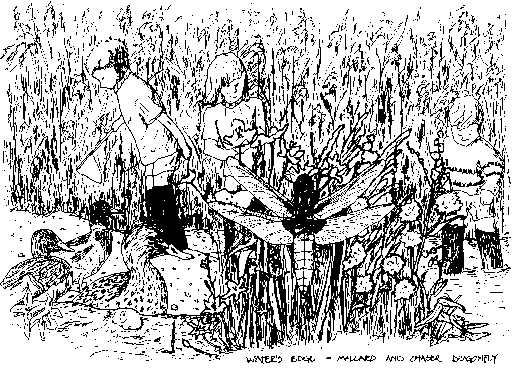
| Home | Credits | Woodland | History | The Year Round | Species | Bibliography | Maps |
Exploring Worcester Woods
Nick Cripps


| Home | Credits | Woodland | History | The Year Round | Species | Bibliography | Maps |

Red Campion flowers from mid-May to October in large drifts inside the coppiced areas of Warndon Wood. Cow-wheat is a pallid, pale-yellow-mouthed flower. Growing in Perry Wood's heath land, it appears to shelter around the solitary oaks. Folk lore has it that pregnant women ate cow-wheat to ensure their child be male!
The sprawling shrub Woody Nightshade, called Bittersweet, prefers semi-shade and damp conditions. It has a revered history, the berries of bittersweet being found in the tomb of Tutankhamen fashioned into a necklace.
The Dog Rose, our unofficial 'English rose', is in bloom. The flower, large and scented, is usually white with a flush of pink. Also occasionally in the meadows is the stocky-stemmed plant Agrimony - its stem a rod of bright-yellow flowers.
Goat's Beard or Jack-go-to-bed-at-Noon, is a fascinating plant of the meadows. Its single yellow flower opens each morning, but promptly shuts again at midday, before the full heat of the afternoon sun. Like the dandelion, goats’ beard develops a white and fluffy seed-clock.
The yellow-flowered Ragwort is the food plant of the cinnabar moth caterpillar. The wasp-coloured, yellow-and-black, caterpillar often invades it in large numbers. Ragwort is a common weed of grazing land and is highly poisonous to livestock.
The Mini Meadow at Nunnery Wood is a sanctuary and nectar source for feeding butterflies and moths. Flowers like Ox-eyed Daisy, Lesser Knapweed, and Spiny Restharrow and all flourish there. The purple-pink Self Heal and pink-petalled Meadow Cranesbill also grow easily amongst the grasses.
Around County Hall pools Yellow Flag is prominent. So too, is Greater Spearwort, a yellow-petalled flower with the look of the buttercup. Growing in small clumps on the dry grass edges is Water Mint. This highly aromatic herb produces reddish pom-pom-like flowers in July.
The familiar Bulrush edges the pools and acts as cover for the breeding bird life. The water cascade between County Hall’s two pools, is a tangle of yellow Water-lilies. The lilies with their large green floating leaves, are sometimes called Brandy bottles because of their distinctive fruit pods.
As the month progresses most songbirds grow gradually quieter, and the Dawn Chorus peters into a pale echo of early May. Cuckoos are scarce, but still heard. Listen too, for the Yellow Hammer calling from the tops of the denser hedgerows.
The commonest butterfly is surprisingly the Meadow Brown and not a ‘white’. This brown butterfly, with orange wing patches, is fond of open grassland and bramble. Huge numbers of meadow browns will be flying through to September.
Individual Marbled White butterflies have been recorded in Perry Wood. The marbled white is a species that rarely travels far from its localised colonies within the County, so consequently it is an infrequent visitor to the Park.

The Azure Damselfly, the Common Blue, and the Blue-tailed are the first damselflies to emerge, and will fly until August. All three are relatively weak fliers and will be concentrated mostly at the water's edge.
The robust Broad-bodied Chaser is the first dragonfly on the wing. The male of the species is stocky, and vivid blue in colour. The female in contrast, is brown with yellow markings and keeps largely out of sight. The Chaser perches on vegetation, making continual sorties for food or to defend its territory. Like all dragonflies it is best seen on warm, sunny days.
Flying tonight in Worcestershire and around the Woods are: the Brown Long-eared Bat, the Pipistrelle, the Noctule Bat - our largest species, and Daubenton's Bat - often called the water bat. The Daubenton's bat has an affinity for water gnats and midges, and is commonly seen swooping low over the pools. Each bat species has its own preferred roosting site and many are attracted to houses, farm buildings, or hollow woodland trees.

Worcester Woods Title Page
Worcestershire History Encyclopaedia